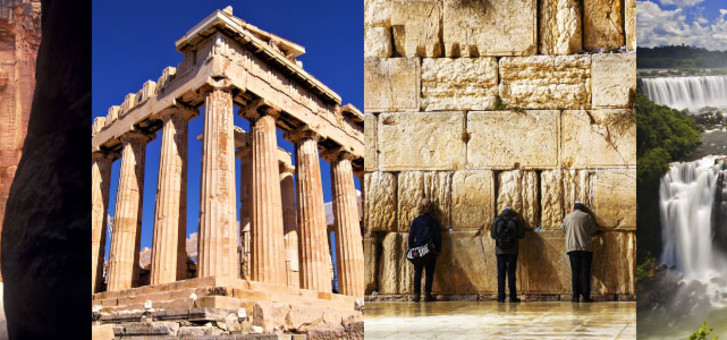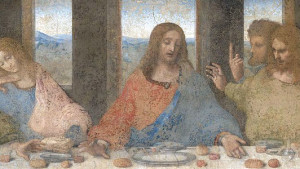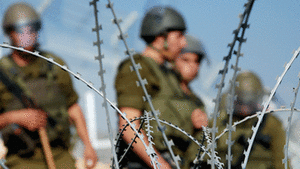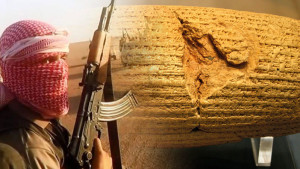In 2014, Diggings conducted two tours. In the previous issue, DIGGINGS editor Gary Webster reported on the Lost Civilizations Tour he led to Egypt, Italy, Mexico and Peru. Now David Currie, a tour leader with a lifetime of experience in the Middle East and North Africa, reports on the second tour, which visited Iran, Jordan, Greece and Turkey.
I led a group through Iran, Jordan, Greece and Turkey in August and September 2014. Our biggest surprise was Iran. I had been there twice before, but that was before the days of Ayatollah Khomeini. In those days, it was a long journey to get to the Behistun Rock carvings, the tombs of Esther and Mordecai at Ecbatana, and the palaces of Shushan where the prophet Daniel is buried. But now the roads are so good, allowing us to more quickly see these special places and much more, and keep moving.
IRAN
The biggest surprise to our group was the friendliness of the Iranian people. For instance, we would be walking through a covered bazaar or downtown Tehran or Shiraz, when people would stop and talk to us in very good English. They wanted to be photographed with us on their iPads or smart phone. They had the latest versions of the technology available in the West. Iran is supposed to be under sanctions, but a visitor would never know it in this amazing country.
The women in our group were forewarned of the necessity to wear a headscarf to cover most of their hair. Although it was somewhat a relief to them to be able take them off when we entered Jordanian territory, the experience was novel. Iranian women have become used to them over the past 40 years or so; in my earlier visits, headscarves were seen only occasionally.
Our first major destination was the Golestan Palace. On my previous visits, one could only photograph the building’s outside; you could not see inside the palace. But now that the Shah’s rule has long since ceased, access is permitted, although you can still not take photographs. It is a magnificent palace, and together with the crown jewels, a visit to the country is a reminder of some of the opulence of the rulers of ancient Persia.
When our children were young, they often had me read the story of Esther and Mordecai from the book of Esther found in the Bible. So during this tour of Iran by bus, the visit to their tombs was quite a spiritual experience. A Jewish caretaker opened up the courtyard and tomb area for us and we could photograph as much as we wished. The city of Hamadan, or Ecbatana, was once a stronghold of Jews and there are still quite a number who live in the area.
Iran is known for its hills and mountains, many of which are covered in snow during the winter. Our journey through Iran took us on roads that traversed some of them and our bus laboured at times to ascend some of the higher altitudes. On one range of mountains are the famous Behistun (Bisotun) rock carvings by Darius the Great. He had his achievements inscribed in the rock face in three languages (Babylonian or old Akkadian, Elamite and Old Persian) enabling the British archaeologist, Henry Rawlinson, to decipher the writings, opening up other ancient records. These are a massive 15m high by 25m wide, being the largest of its kind in the world. As they are located some 100 metres up the cliff face it took a real effort for the archaeologist to take the imprints that he needed. Even today, it’s no mean feat to reach the carvings. The area below the inscriptions is well preserved, and today it is a popular tourist destination for local Iranians as well as visitors.
The archaeological diggings and restorations at Shushan (Shush or Susa) were vast, and this amazing area has so much to offer those interested in archaeology and biblical backgrounds. It was here and near here that the story of Esther unfolded (see Esther 1:2, 5; 2:3, 8) and the prophet Daniel appeared in the palace of the Persian kings and received his visions of the future (see Daniel 8:2; Daniel 10:4). It is without doubt that it was at this palace that he served as prime minister for the Persians, having also served in a similar position in Babylon, particularly under King Nebuchadnezzar (Daniel 6:1–3). In fact, the city of Babylon is only 300 kilometres away across the Tigris River. In the heart of modern day Susa is the tomb of Daniel. Jews, Christians and Muslims alike revere him, though when we visited it was in the care of Muslims who were very friendly toward our group.
Writing about the tomb of Daniel reminds me of our visit to the tombs of Cyrus the Great at Pasargadae and the tombs of Darius the Great and Artaxerxes in the Valley of the Persian kings, known as Naqsh E Rostam. The tomb of Cyrus the Great is an outstanding tomb near the ruins of the city of Pasargadae on a wide plain, while the tombs of Darius the Great and Artaxerxes are carved out of a significant cliff face amid mountains a few kilometres away.
Our last visit to a place of significance in Iran was to the Summer Palace of the Persian kings at Persepolis. This vast palace area was used by the last shah of Persia, Shah Mohammad Reza Pavlevi, to celebrate the 2500th year of the continuous reigns of the kings of Persia. Celebrities from around the world joined in the celebrations. The palace is very well preserved, although in some places is re-constructed.
A very early morning flight from Shiraz, took us to Doha and on to Amman, Jordan.
JORDAN
Our time in the Kingdom of Jordan, while brief, was well spent. Our first stop was a splendid afternoon visit to the citadel in the heart of Amman. This is a must-see for tourists, as it contains a very fine archaeological museum and ruins that go back some three-and-a-half millennia. It is also a great place from which to view much of the city of Amman, both modern and ancient. Below the citadel and very close is a well-preserved Roman amphitheatre.
Our second day took us to the old city of Jerash, about 48 km north of Amman. On the way, we crossed over the picturesque brook Jabbok. It is believed to be near this site that Jacob wrestled with the angel (Genesis 32:22–30) and had his name changed from Jacob to Israel. Jerash (biblical Gerasa) is a well-preserved city. It was founded by Alexander the Great around 365 B.C.., and boasts Greek and Roman architecture. Unfortunately, the Muslims destroyed much of the city about a thousand years after it was founded. Even so, it is a splendid example of a large ancient city.
Our group then took a three-hour trip to Petra, where we stayed in the very new Panorama Hotel. Petra was established by the Edomites, the descendants of Esau, the twin elder brother of Jacob. En route back to Palestine after their Exodus from Egypt, these cousins of the Israelites refused them permission to travel through their country (Numbers 20:14–18). Israel was forced to take a longer route through Moab. Centuries later, the Edomites were displaced by the Nabateans, who are largely responsible for the rock-hewn caves, temples and buildings seen there today.
At its peak, under the Nabateans, it boasted around 30,000 inhabitants. Today, it’s visited by at least 500,000 tourists yearly. The Siq, with towering cliffs, is nearly two kilometres long. Depending on time of day and the season, the Siq offers different hues, from brown to a light pink. The first view of at the end of Siq is the “Treasury” or Al Khazneh. This beautiful piece of work is not a building as such but was left as the cliff face was carved away. It is a remarkable achievement and similar to the larger Temple of Ed Deir about three kilometres further up the valley.
Our group didn’t have time to go to Ed Deir, but many climbed up the steep stairway to the altar where the ancients made sacrifices. Near the top are a couple of Massebah pillars, left when the top of the mountain was carved away. These represented deities to the ancients. Then there is the pool where it is believed ritual washings of the priests and sacrifices occurred in preparation for sacrifice on the altar. Some believe human sacrifice took place at this site, though this is yet to be proved. From the altar one can see many of the sites of Petra, even the urn on the top of the Temple of Ed Deir. One also gets a magnificent view of Mt Seir (Um El Biyara), which is believed to be the site where Israel King Amaziah completed his destruction of the Edomites by throwing them from the cliffs of the mountain (2 Kings 14). It is of further interest that the prophets of the Old Testament wrote against Idumea and Edom, which the site of Petra was part of. For example Jeremiah, writing around 600 B.C.., said:
“The pride of your heart, O you who dwell in the clefts of the rock, who hold the height of the hill! Though you make your nest as high as the eagle, I will bring you down from there, says the LORD. Edom also shall be an astonishment; everyone who goes by it will be astonished” (49:16, 17).
A similar prediction is found in the small biblical book of Obadiah:
“The pride of your heart has deceived you, you who dwell in the clefts of the rock, whose habitation is high; you will say in your heart, who will bring me down to the ground? Though you ascend as high as the eagle and though you set your nest among the stars, from there I will bring you down,” says the Lord (verses 3, 4).
It is amazing how these predictions were so accurately fulfilled!
GREECE
The original Diggings tour itinerary was to take us to Israel, but due to the conflict along the Gaza border at the time of final planning, it was decided to change to Greece. I’ll concentrate on the less well known places visited outside of Athens, Corinth and Thessalonica.
Delphi is well up in the foothills of Mount Parnassus at an elevation of some 600m about 180km northwest of Athens. It is probably one of the most famous of historical cult sites in the world, with its Sanctuary of Apollo and the oracle Sibyl, sometimes called Pythia. Rulers and army generals consulted the oracle, originally a young virgin but later a more senior woman with an impeccable background. The oracle was alleged to have a gift of prophecy, able to tell leaders how to conduct their wars. Interestingly, they were very often successful!
There too are the remains of a 5000-seat theatre where plays depicted such things as the struggle between Apollo and the Python. Then there is the stadium where the Pythian games were held beginning in 590 B.C., which were the likely forerunner to the Olympic games.
Meteora (“in the air”) takes first-time visitors quite by surprise; the group was impressed with the monasteries built on top of the rock outcrops. There are 24 perpendicular rock formations of up to 300m in height and separated by precipitous drops and ravines, but only a few have monasteries today. Monks of the Orthodox Church have inhabited these since the eleventh century. We visited three that are in pristine condition.
The tomb of Philip of Macedon at Vergina is very impressive. Philip was the father of Alexander the Great. His tomb is one of the more recent (1977) archaeological finds and the Greeks have turned it into something well worth visiting. The site consists of several remarkably well-preserved tombs in very close proximity, in an underground area, with a fine museum displaying recovered artefacts. Among the most significant is the larnax or coffin of Philip II. The wooden box containing Phillip’s bones was covered with thick sheets of gold, together weighing almost eight kilograms. There were hundreds of other objects in gold, silver and iron in almost pristine condition.
TURKEY
This country is rich in history, archaeological diggings and fascinating natural beauty. After a side trip to Gallipoli, we went to Bergama with its ancient city of Pergamos towering on the hill above. There is a cable car conveying visitors to the old city and its archaeological diggings on top. We could only wonder at the funds spent by the Turks in making their archaeological sites attractive to tourists. This was evident at many of the sites visited, including ancient Smyrna and Laodicea, all three cities being mentioned in the biblical book of Revelation as part of a sisterhood of seven Christian churches of the wider area established in first century A.D.. Our travels included a stop at Antioch (in Pisidia, see Acts13:14–44) as we made our way to most fascinating of Turkish destinations, Cappadocia.
Ah, Cappadocia! One of the most wonderful places in the world—above and below ground. Its underground cities, tunnelled vertically deep underground for protection, were first built by the Hittites, and then expanded by the area’s persecuted Christians. Some are as many as 10 stories deep, connected by many kilometres of tunnels to homes, communal cooking areas, even churches with baptisteries—fascinating, and not for the claustrophobic. But the most attractive part of Cappadocia is visible above ground with its hundreds of pinnacles that once excavated became the homes of thousands of refugee Christians for many centuries. Each pinnacle is different, and best viewed from a balloon of which more than 100 might be in the air during the tourist season.
Last on our list were to two sites of the ancient Hittites at Hattusa and Bogazkoy. The first Hittite city to be found was at Carchemish in 1905. Prior to that discovery, many authorities felt that the Hittites, although mentioned numerous times in the Bible, were a mythical race and non-existent. Today some 36 Hittite cities have been identified. The centre of their activities appears to have been Hattusa, where sanctuaries and temples have been discovered. The Anatolian Museum in Ankara is home to many of the artefacts found in these sites.
And there our journey came to its end, returning to Istanbul for a flight home. Some of the group went to other European destinations, while others joined the Great Museums Tour in London with DIGGINGS’s editor, Gary Webster.
For more information on upcoming tours click here






